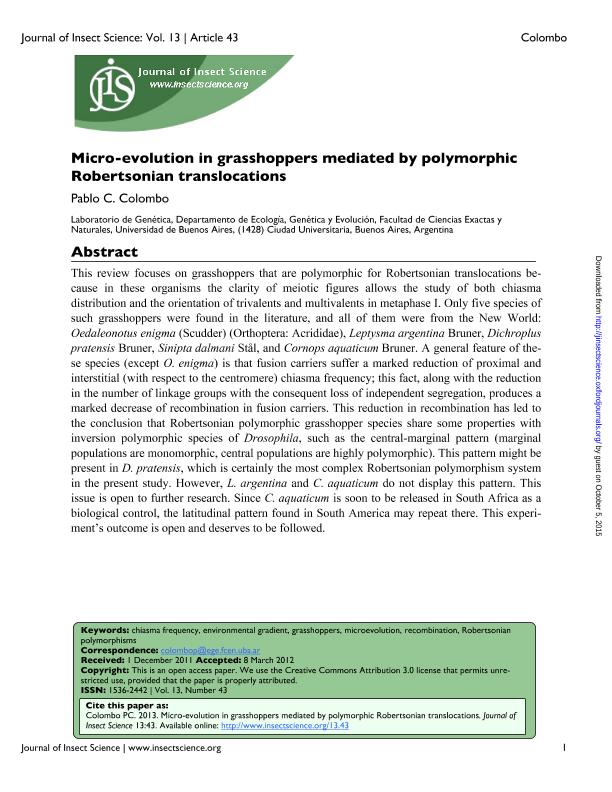Mostrar el registro sencillo del ítem
dc.contributor.author
Colombo, Pablo Cesar

dc.date.available
2015-10-05T20:03:14Z
dc.date.issued
2013-01
dc.identifier.citation
Colombo, Pablo Cesar; Micro-evolution in grasshoppers mediated by polymorphic Robertsonian translocations; Oxford University Press; Journal of Insect Science; 13; 1; 1-2013; 1-22
dc.identifier.issn
1536-2442
dc.identifier.uri
http://hdl.handle.net/11336/2334
dc.description.abstract
This review focuses on grasshoppers that are polymorphic for Robertsonian translocations because in these organisms the clarity of meiotic figures allows the study of both chiasma distribution and the orientation of trivalents and multivalents in metaphase I. Only five species of such grasshoppers were found in the literature, and all of them were from the New World: Oedaleonotus enigma (Scudder) (Orthoptera: Acrididae), Leptysma argentina Bruner, Dichroplus pratensis Bruner, Sinipta dalmani Stål, and Cornops aquaticum Bruner. A general feature of these species (except O. enigma) is that fusion carriers suffer a marked reduction of proximal and interstitial (with respect to the centromere) chiasma frequency; this fact, along with the reduction in the number of linkage groups with the consequent loss of independent segregation, produces a marked decrease of recombination in fusion carriers. This reduction in recombination has led to the conclusion that Robertsonian polymorphic grasshopper species share some properties with inversion polymorphic species of Drosophila, such as the central-marginal pattern (marginal populations are monomorphic, central populations are highly polymorphic). This pattern might be present in D. pratensis, which is certainly the most complex Robertsonian polymorphism system in the present study. However, L. argentina and C. aquaticum do not display this pattern. This issue is open to further research. Since C. aquaticum is soon to be released in South Africa as a biological control, the latitudinal pattern found in South America may repeat there. This experiment’s outcome is open and deserves to be followed.
dc.format
application/pdf
dc.language.iso
eng
dc.publisher
Oxford University Press

dc.rights
info:eu-repo/semantics/openAccess
dc.rights.uri
https://creativecommons.org/licenses/by/2.5/ar/
dc.subject
Centric Fusions
dc.subject
Orthoptera
dc.subject
Chiasma Frequency
dc.subject
Environmental Gradient
dc.subject.classification
Zoología, Ornitología, Entomología, Etología

dc.subject.classification
Ciencias Biológicas

dc.subject.classification
CIENCIAS NATURALES Y EXACTAS

dc.subject.classification
Biología

dc.subject.classification
Ciencias Biológicas

dc.subject.classification
CIENCIAS NATURALES Y EXACTAS

dc.title
Micro-evolution in grasshoppers mediated by polymorphic Robertsonian translocations
dc.type
info:eu-repo/semantics/article
dc.type
info:ar-repo/semantics/artículo
dc.type
info:eu-repo/semantics/publishedVersion
dc.date.updated
2016-03-30 10:35:44.97925-03
dc.journal.volume
13
dc.journal.number
1
dc.journal.pagination
1-22
dc.journal.pais
Reino Unido

dc.journal.ciudad
Londres
dc.description.fil
Fil: Colombo, Pablo Cesar. Consejo Nacional de Investigaciones Científicas y Técnicas. Oficina de Coordinación Administrativa Ciudad Universitaria. Instituto de Ecología, Genética y Evolución de Buenos Aires; Argentina. Universidad de Buenos Aires. Facultad de Ciencias Exactas y Naturales. Departamento de Ecología, Genética y Evolución. Laboratorio de Genética; Argentina
dc.journal.title
Journal of Insect Science

dc.relation.alternativeid
info:eu-repo/semantics/altIdentifier/url/http://jinsectscience.oxfordjournals.org/content/13/1/43.article-info
dc.relation.alternativeid
info:eu-repo/semantics/altIdentifier/url/http://www.ncbi.nlm.nih.gov/pmc/articles/PMC3740932/
dc.relation.alternativeid
info:eu-repo/semantics/altIdentifier/doi/http://dx.doi.org/10.1673/031.013.4301
Archivos asociados
